Core Stability Manual





YMCAfit is a CIMSPA Training Provider Partner and are authorised to have this training module recognised and assigned Continuing Professional Development (CPD) points by CIMSPA

All rights reserved. Without limiting the rights under copyright reserved above, no part of this publication may be reproduced, stored in or introduced into a retrieval system or transmitted, in any form or by any means (electronic, photocopying, recording or otherwise), without the prior written permission of the copyright owners of this resource.
Introduction ..............................................................................................................................1
Swiss ball and BOSU exercises....................................................................................................3
Press up .............................................................................................................................................................4
Teaching points 4
Small knee bend ................................................................................................................................................4
Teaching points...................................................................................................................................................5
Manual resistance lunge 6 Teaching points 6
Diver ..................................................................................................................................................................7
Teaching points 7 Side lying oblique curl 7
Teaching points...................................................................................................................................................7
Supine hamstring roll 8 Teaching points 8
Russian twist......................................................................................................................................................9
Teaching points 9
Front leg bosu lunge and thoracic twist 9
Teaching points.................................................................................................................................................10
Prone alternative push/pull.............................................................................................................................10
Teaching points 10
Standing bosu ball pass/twist 11
Teaching points.................................................................................................................................................11
Standing tubing rotation 12
Teaching points 12
Hop and stick (anti-pronation of foot/knee control) ......................................................................................12
Teaching points 12
Foam roller exercises...............................................................................................................14
Heel taps/single leg lifts 15
Teaching points 15
Bent knee fallout .............................................................................................................................................15
Teaching points 15
Single
Teaching points.................................................................................................................................................16
Teaching points.................................................................................................................................................18
Horizontal
Core stability has become an umbrella term referring to many forms of training approach ranging from those seen within clinical rehab to those seen within the strength and conditioning world and everything in between. For the purposes of this course we have interpreted ‘stability’ as meaning ‘control of movement’, both statically and dynamically rather than just the ability to resist displacement. Although the region of the ‘core’ is still fundamentally challenged by the exercises in this manual, attention to alignment and control of movement has been expanded to include the whole body and not just the trunk. This means control of the foot, knee and ankle will be considered with the same scrutiny as the spine.
If we consider there to be two basic classifications of core stability exercise, static or dynamic, it allows us simplify a classification which can, on the surface, seem very complex. Exercises can either be core stability in which we maintain a static position or core stability in which we move through a desired range of motiondynamic.
Exercises like the plank and side plank would fall under the first type of exercisestatic. The client finds and then maintains their individual ‘neutral’ position. Once they lose this position due to fatigue, loss of co-ordination or loss of awareness and can no longer return to their neutral the exercise should stop.
Exercises which require the client to move through a desired range of motion are also considered to be an effective core stability exercise as long there is control within their performance. This allows traditional abdominal exercises like the crunch and back extension to be included as ‘core’ work.
If we want to improve a client’s ability to hold a position with control we need to know where a position should be held. The mid-position of the joint has been used as a desirable place to encourage clients to find and work. This position is termed ‘anatomical neutral’. Current thinking suggests that finding a ‘client specific’ midposition to work in is more achievable and less dogmatic than always expecting a ‘perfect position’ to be attained. For the low back region, we ask clients to tilt their pelvis forward and backwards and then ask them to stop at their mid-position between the two. This allows us to work the client in ‘their neutral’ as opposed to what might be an extreme for them.
The box or four point position is a comfortable place to start when finding a client’s specific neutral throughout the length of the spine. With the hands below the shoulders and the knees below the hips the client tilts their pelvis forwards and
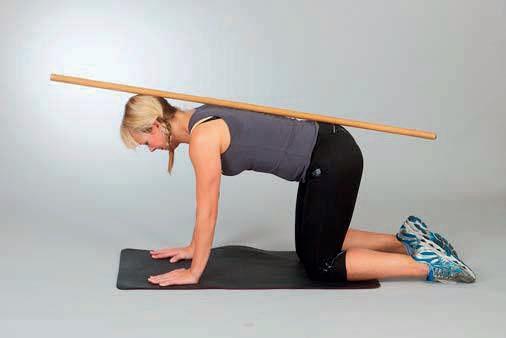
A place to start for core stability holds
backwards, flexing and extending the lower back. A position is maintained that is half way between their fully flexed and fully extended.
The upper back and neck should also have curves so that when a dowel rod is placed on the tailbone it should make contact just between the shoulder blades and the back of the head at the base of the skull. Some clients will not feel comfortable actually having a stick placed on their back in this way, but some will see the benefits of the feedback it supplies to them and to you as a trainer.
Ideally the stick can remain in contact with the three points and the curves of the spine which were initially found, can be maintained as a variety of factors are introduced to provide just the right amount of challenge. If two points out of the three can be found, the dowel rod is still a valid option.
With a hip width stance and the feet ideally parallel, the body weight should rest on the heel, ball of foot and outside edge of the front of the foot. Allow the client to become aware of the arches in their feet, finding a midposition between a flattened and a highly arched shape.
Allow the knees to align with the second toe. Tilt the pelvis as for the four point exercise, finding a client specific neutral. Check the ribs are not ‘flaring’, an indicator of excessive opening in the upper back. Allow the shoulder blades to produce a gently lifted ‘squared’ shoulder neither pulled down nor excessively ‘hitched’. Keeping the jaw parallel to the floor is still a relevant teaching point as most clients will need to bring the head gently back over their trunk whilst keeping their chins tucked in.
Beware of ‘well built’ glutes giving the impression of a deep low back curve. Ask the client to tilt the pelvis forwards and backwards and again find their mid-position. If they cannot ‘extend’ the spine/ tilt the hips forwards, it suggests the low back is already excessively curved.
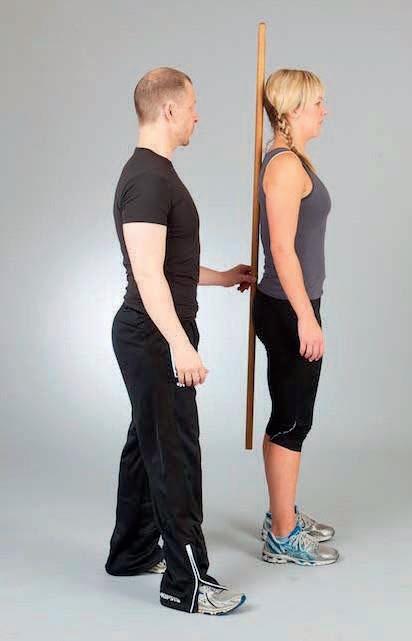

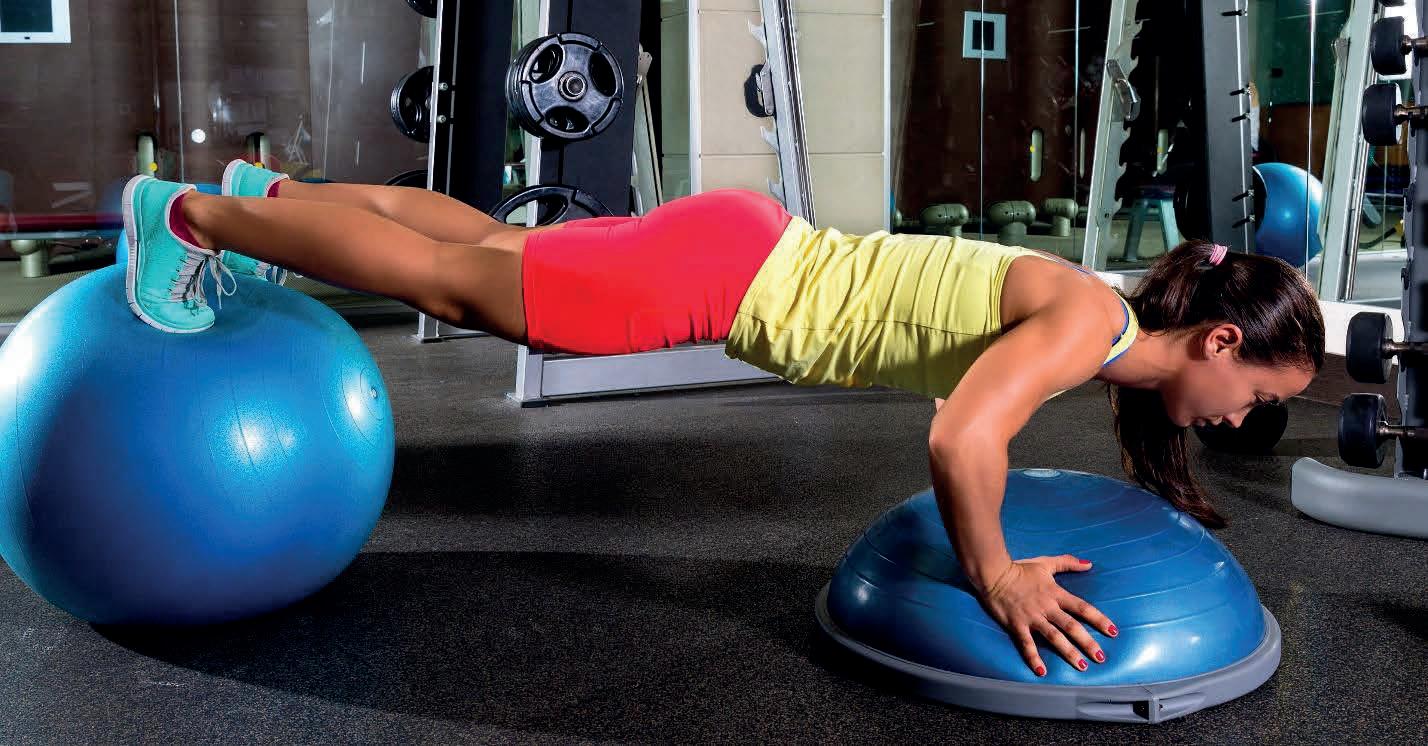
Personal trainers need to be aware of, and skilled in, an array of equipment, both familiar and new. The Swiss ball has become firmly established in and out of gyms as a tool to modify an exercise by sometimes making it easier or more comfortable, or by making it harder often through performing an exercise with less stability. Arriving in the fitness arena from the therapeutic world, the Swiss ball has received criticism as it has been used in a very different way from its rehab-focused beginnings. However, its versatility can be a strength when used well. Trainers are advised to always weigh up the needs of their client and employ the best tool for the job. The exercises chosen for this seminar hopefully offer the best of the ball’s applications.
The ball has gained popularity due to its multitude of uses and its low cost, but some have questioned its appropriateness with regards to safety. In response to these concerns but in the knowledge that clients and trainers wanted an unstable challenge, the BOSU was developed. The ‘quarter’ sphere of a David Weck’s BOth Sides Up ‘BOSU’ offered many of the benefits of its predecessor but with fewer injury concerns.
As a new found interest in ‘functional training’ emerged within the industry, the desire to perform lower limb, closed chain exercises was met by the BOSU in a way that was arguably very unsafe on a ball.
As with the ball, a ‘greatest hits’ selection has been picked for this seminar as to how to use the BOSU most effectively.
Muscles targeted
pectorals – producing shoulder joint horizontal flexion
triceps – producing elbow extension
serratus anterior – controlling scapula
winging abdominals – controlling lumbar extension

oblique abdominals – when performing the exercise with only one leg.
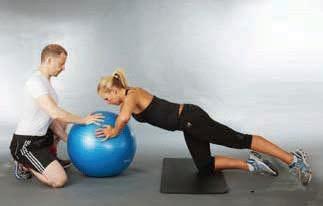
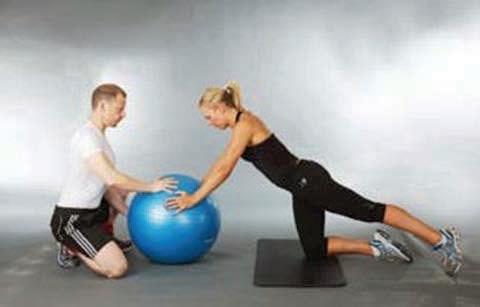
position the ball against a strong wall
kneel; facing the ball so that arms may be placed with the hands shoulder width or wider on the upper side of the ball and the scapula flat around the ribcage
keep the wrists in a middle, neutral position
find and maintain a neutral spine alignment
extend the legs so that the body is supported by the hands on the ball and the feet from below
bend at the elbow and lower the chest towards the ball and slowly return without locking the elbows.
Muscles targeted
quadriceps - producing knee extension

gluteus maximus - producing hip extension
gluteus medius - preventing medial rotation of hip
gluteus medius and obliques - preventing hip adduction
oblique abdominals - preventing lumbar extension
tibialis posterior - preventing pronation of foot.

position the ball to rest against a wall at just below hip height
position yourself so that the ball is to your side supported against the outside of the thigh
bend the knee of the leg supporting the ball as you come into a single leg support
the support foot’s second toe, knee and navel should be aligned
the natural arch of the support foot should be maintained
the pelvis remains aligned and the spine remains in a neutral position
slowly bend at the knee and hip to perform a shallow, single leg squat
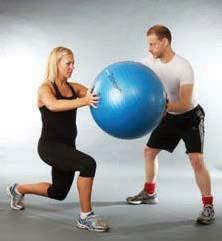
Muscles targeted
quadriceps - producing knee extension
gluteus maximus - producing hip extension
gluteus medius - preventing medial rotation of hip
gluteus medius and obliques - preventing hip adduction
oblique abdominals - preventing lumbar extension
tibialis posterior - preventing pronation of foot
oblique abdominals – preventing trunk rotation
posterior deltoid – preventing shoulder joint horizontal flexion
pectoral major – preventing shoulder joint horizontal extension.
hips aligned forwards, position feet four foot lengths apart
align knee and second toe forwards on the front leg and lift the rear heel but ensuring that the inside edge of the foot doesn’t lift more than the outside
sink down into a lunge position of a right angle at both knees
extend the arms in front of the body with arms at shoulder level
maintain neutral alignment through spinal curves and scapula
the trainer now supplies manual resistance to the ball with the aim of challenging the client’s alignment control
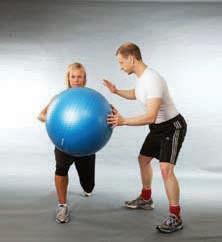
pressure can be from the sides, above or below but inform the client when and where the resistance will be added and with how much force.

Muscles targeted latissimus dorsi - producing shoulder joint extension
abdominals - preventing lumbar extension
serratus anterior - controlling scapula winging.
lie prone with the mid-thigh region supported by the ball
hands are below the shoulder joint with the scapula and spine in a neutral position
push slowly back with the arms until the ball rests on the lower abdominal region
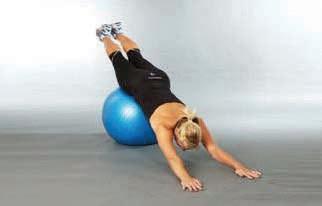
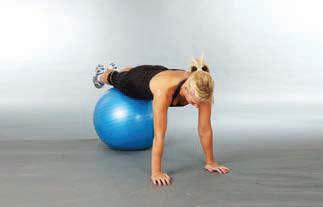
begin to pull through the arms to return to the start position preventing the lower back from arching or the scapula from winging.

Muscles targeted
obliques, abdominals and quadratus lumborum - producing trunk lateral flexion.
come down to kneeling in a lunge position side on to a stable wall so the rear leg is nearest the wall
arrange the ball to the front leg side
slowly transfer your trunk to be supported by the ball as the feet now anchor the body from the wall support
ensure during this transition the hips remain forwards
curl the trunk around the ball as the body goes into full lateral flexion on the ball side
under control curl up to just less than vertical. Return under control.
Muscles targeted
hamstrings - producing knee flexion
gluteus maximus - preventing hip flexion
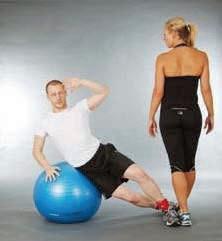
lower back extensors - preventing lumbar flexion.

lie supine with the soles of the feet supported by the ball from below and the knees fully flexed

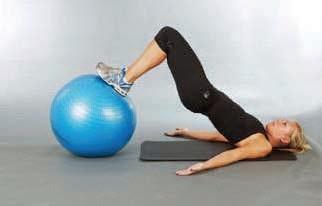
keeping control through the body gently lift the hips so that the upper trunk and soles of the feet support the body
slowly extend the knees and return preventing the hips from rolling or the neutral alignment of the spine from changing.

Muscles targeted
gluteus maximus - preventing hip flexion
gluteus medius – controlling hip medial rotation
oblique abdominals – producing trunk rotation.

lie supine on the ball with head and shoulders supported
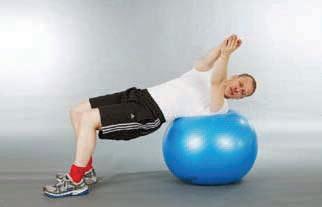
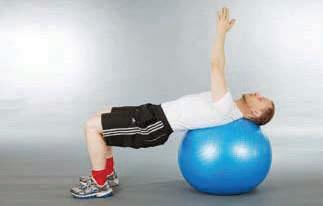
feet hip width and secure
align the curves of the spine
rotate the trunk so that the shoulders and hips move as a block, with this movement happening from the hip joint as the legs stay.
Muscles targeted
quadriceps - producing knee extension
gluteus maximus - producing hip extension
gluteus medius - preventing hip medial rotation
oblique abdominals - preventing lumbo-pelvic rotation
oblique abdominals - producing thoracic rotation.
lunge forwards to place the foot directly on top of the soft side up of the bosu
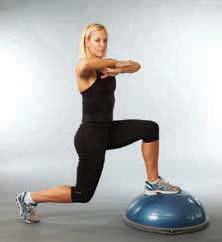

aim to prevent excessive side bend of the trunk or turning in of the front knee
slowly lift and return to floor before alternating
aim to maintain a neutral lower back curve throughout the whole exercise
add a thoracic twist to increase control challenge
rotate towards the forward leg to increase the challenge at the knee.
serratus anterior - preventing scapula winging
oblique abdominals - preventing lumbar extension
oblique abdominals - controlling trunk rotation
pectoral major and triceps - producing ‘pushing action’

biceps & latissimus dorsi (plus pulling muscles of shoulder girdle) - producing ‘pulling action’
soft side of the bosu is against the floor as you are positioned in a prone position with the arms shoulder width apart securely holding the bosu’s edges
the legs are extended so that the body is supported through the arms and feet
align and maintain scapula and spinal curves

pull one edge of the bosu up and the opposite side is pushed away, flexing and extending the elbow
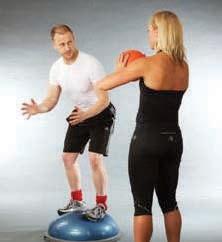

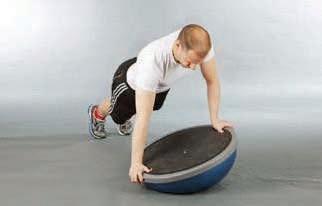
aim to limit the amount of trunk movement as the bosu is rocked slowly up and down.
Muscles targeted
quadriceps, gluteals, adductor group and abductors - isometrically hold position
oblique abdominals - produce and control ‘twist/rotation’
quarter squat position on the bosu
align the spine in a neutral position
trainer throws an appropriate sized medicine ball from the front or side to be caught by the client
aim to counter the disruption in alignment from the ball been caught or thrown back to the trainer.
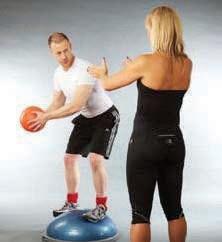
Muscles targeted
quadriceps, gluteals, adductor group and abductors - isometrically hold position
oblique abdominals - produce and control ‘twist/rotation’
quarter squat position on the bosu align the spine in a neutral position
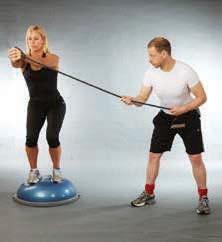
extend the arms out at mid-chest level with a bend at the elbows holding some resisted tubing anchored out to one side of the bosu
slowly rotate the thoracic spine preventing any compensatory movement below

return to the start position
maintain a neutral position of the scapula.
Muscles targeted
tibialis posterior - controlling foot pronation
gluteus medius and obliques - controlling hip adduction and medial rotation gluteus maximus - controlling hip flexion.
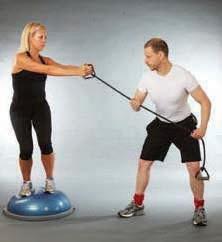
from a floor-based single leg stance find a level pelvis, neutral spine and gently arched foot
knee and second toe should align with the navel above
hop to land on the soft side up of the bosu aiming to maintain or at least return to the original alignment found.
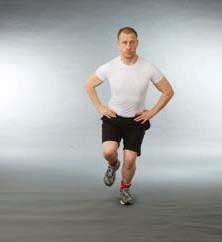
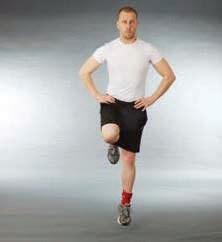

Foam rollers are a versatile addition to the personal trainer toolkit. The myofascial release aiding qualities of the foam roller are employed to help clients loosen restrictions before or after workouts. As foam rollers can be found in gyms and Pilates studios, it is useful to know what other benefits we can get from training with them.
This seminar aims to explore how foam rollers can be used to challenge and improve a client’s core stability. As a foam roller literally wants to roll it can be used as an effective tool to challenge key core stability muscles, namely the obliques and gluteals but also many others.

The foam roller provides an unstable surface which challenges the clients’ motor skills – a key element of effective core training. It can also be used as a proprioceptive prop. This allows the trainer to give immediate feedback to the client about their body position, alignment and control of movement which forms the fundamental principles of core training.
To show its versatility, the foam roller can also be used as a bench, as would be found in a gym’s free weights area. This idea allows for the inclusion of some familiar resistance training ideas with a slightly different emphasis. To get the most from the foam rollers rotational challenge, single arm exercises are included using both dumbbells and tubing. It is worth noting at this point that if we are training for maximal strength or hypertrophy a secure and stable base is still the best option. These are not the goals we are looking to achieve here.
A final benefit, important for freelance personal trainers, is that the foam roller can be very portable. This allows trainers to carry their foam roller in a backpack or even in place of a backpack
Consider that although a soft foam roller usually offers more comfort to clients, the harder foam rollers have greater longevity. Also, in many examples the foam roller is a progression of a simpler and perhaps more appropriate exercise. The tool should be employed only once it is required and with a specific aim in mind.
For exercises which involve laying on your back (supine) it is recommended clients sit very close to one end of the roller and then use their hands to guide themselves comfortably down to lying so that their head is supported
Muscles targeted
oblique abdominals - preventing lumbar extension
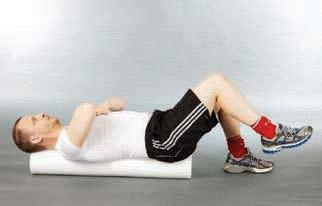
lie supine on the foam roller so that the head and sacrum are supported find a neutral position for the length of the spine, including the neck
the soles of the feet are comfortably placed on the floor with the knees bent
draw awareness to maintaining this alignment as one foot is gently lifted from its original hip width stance
the knee can remain bent as the knee is potentially lifted to be above the hip
slowly return to the start position aiming to prevent breath holding or visible ‘doming’ of the abdominal region

alternate legs.
Muscles targeted
iIpsi-llateral internal oblique and contra-lateral external oblique towards the moved legpreventing lumbo-pelvic rotation
lie supine on the foam roller so that the head and sacrum are supported find a neutral position for the length of the spine, including the neck
the soles of the feet are comfortably placed on the floor with the knees bent
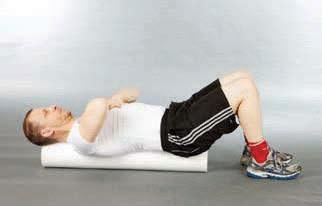
draw awareness to maintaining this alignment as one knee is slowly rotated laterally towards the floor from the hip
return to the start position without altering the body’s alignment alternate sides.
Muscles targeted
obliques -preventing lumbo-pelvic rotation
ipsi-lateral gluteals - preventing hip flexion and hip medial rotation
oblique abdominals - preventing lumbar extension and rotation of low back/pelvis
lie supine on the foam roller so that the head and sacrum are supported
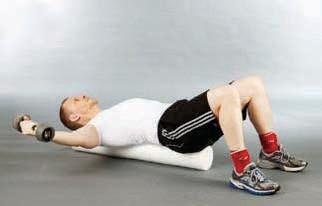
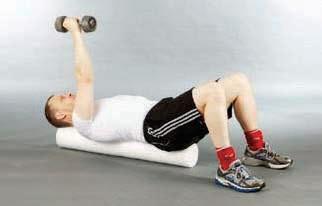
find a neutral position for the length of the spine, including the neck
the soles of the feet are comfortably placed on the floor with the knees bent
draw awareness to maintaining this alignment as one arm performs a ‘flye’ action

a dumbbell is added to this arm to add greater resistance on the muscles producing the movement in addition to a greater control challenge on the muscles preventing a change in alignment
return to the start position without altering the body’s alignment.
Muscles targeted rectus abdominus - preventing lumbar extension when double legged
obliques - preventing lumbar extension when single legged
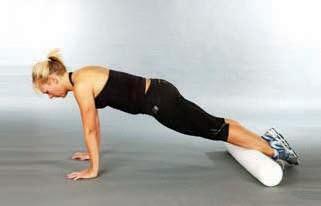
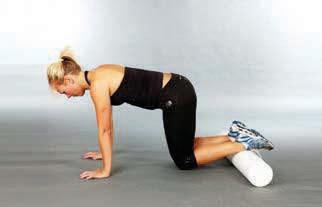
serratus anterior - preventing scapula winging
from a box press-up type alignment, position the hands below the shoulders with the scapula ideally flat around the ribcage

knees are bent and directly below the hips
the spine is aligned in a neutral position both shins are balanced on a foam roller which is slowly rolled away from the body as the legs extend the original points of alignment are maintained both as the legs extend and then return to a start position. the single leg option or ‘running man’ requires only one shin to be supported by the roller as one leg and hip extend, the opposite leg flexes at the knee and hip to produce a running like action the same alignment is aimed to be maintained throughout the spine, pelvis and scapula regions.
Muscles targeted
gluteus medius and contra-lateral obliques - preventing hip adduction on weight bearing leg
assume a quarter squat position with feet wider than hip width and one foot positioned on a foam roller so that the roller can be both rolled away from and towards the body from the side
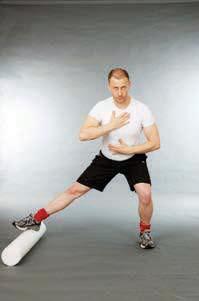
maintain the alignment of the weight bearing foot and leg so that the second toe aligns with the knee
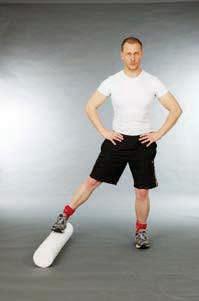
keep the pelvis level and the lower back in a mid-position as the roller supported leg abducts and adducts away and towards the start position
rotate the thoracic spine towards the abducted hip for a greater control challenge.
Muscles targeted
gluteals - on front leg - preventing medial rotation of hip, adduction of hip and hip flexion
oblique abdominals on front leg - preventing lumbar extension
ipsi-lateral external oblique and contra-lateral internal oblique - preventing lumbopelvic rotation as the weight bearing leg.

lie supine so that the roller is parallel to the hips and shoulders
support the head with hands
find a neutral alignment through the trunk and neck

from a hip width stance raise the hips and one foot into a single leg bridge position
roll forward so as to flex the weight bearing knee and then return to start position
keep foot down throughout
prevent hips rolling or lower back curve changing.
serratus anterior - preventing scapula winging
oblique abdominals - preventing thoracic and lumbar extension gluteus mediuspreventing hip adduction
adductor group - preventing hip abduction on straight leg
kneeling on a mat place one supporting hand on a foam roller to the side of the body whilst maintaining a neutral spine


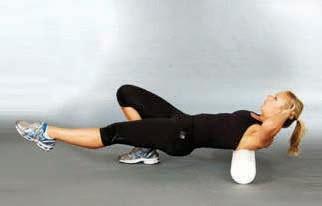
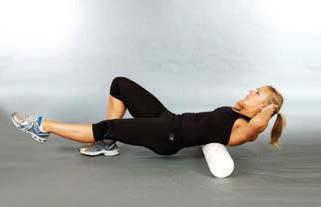
ensure the scapula stays flat around the ribcage as the top leg is lifted and then flexed and extended at the knee to create a rotational challenge
the underside of the trunk should be prevented from sagging towards the floor.
Muscles targeted
contra-lateral oblique abdominals - preventing lateral flexion towards the moving arm
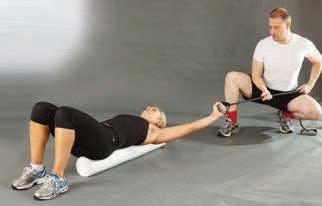

side oblique abdominals and gluteals - preventing rotation towards the moving arm
latissimus dorsi - producing shoulder joint adduction
lie supine on the foam roller so that the head and sacrum are supported find a neutral position for the length of the spine, including the neck
the soles of the feet are comfortably placed on the floor with the knees bent
draw awareness to maintaining this alignment as one arm adducts resisted tubing towards the side of the trunk and then slowly returns under control
return to the start position without altering the body’s alignment.
Muscles targeted
oblique abdominals and gluteals – preventing rotation towards the moving arm
ipsi-lateral oblique abdominals – preventing lateral flexion away from the moving arm
medial deltoids – producing abduction
lie supine on the foam roller so that the head and sacrum are supported find a neutral position for the length of the spine, including the neck
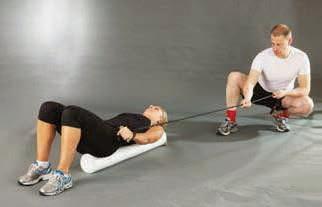
the soles of the feet are comfortably placed on the floor with the knees bent
draw awareness to maintaining this alignment as one arm abducts resisted tubing
towards the side of the trunk and then slowly returns under control
return to the start position without altering the body’s alignment.
Muscles targeted
oblique abdominals (more rectus abdominus if two arms are used) - preventing thoracic extension
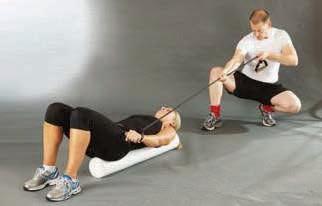
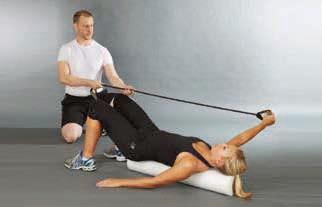
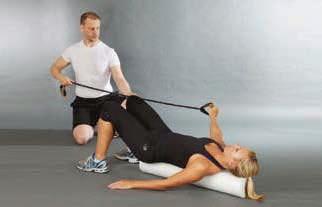
oblique abdominals and gluteals - preventing rotation towards moving arm
latissimus dorsi - producing extension
lie supine on the foam roller so that the head and sacrum are supported find a neutral position for the length of the spine, including the neck

the soles of the feet are comfortably placed on the floor with the knees bent
draw awareness to maintaining this alignment as one arm extends against resisted tubing from behind the head to directly above the shoulder joint
return to the start position without altering the body’s alignment.

oblique abdominals and gluteals - preventing lumbo-pelvic rotation
oblique abdominals - preventing lumbar extension as hip extends
low back extensors - preventing lumbar flexion as hip flexes
lie supine on foam roller so that the head and sacrum are supported
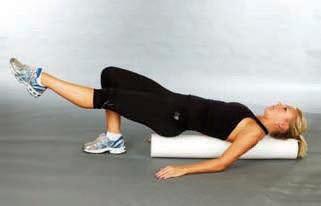
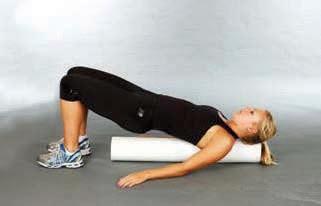
find a neutral position for the length of the spine, including the neck
the soles of the feet are comfortably placed on the floor with the knees bent lift the hips from the roller about two centimetres into a low bridge position
draw awareness to maintaining this alignment as one knee flexes and foot lifts so that knee is placed on top of hip
extend the hip and knee and then lower the heel towards the floor
alternate sides.

latisimus dorsi - producing shoulder joint extension erector spinae group - producing thoracic extension
serratus anterior and trapezius - preventing scapula winging and dropping
oblique abdominals and rectus abdominus - preventing lumbar extension
lie supine with palms facing one another, shoulder width apart and forearms resting on a foam roller
maintain a squared neutrally aligned scapula position and a neutral lower back as the arms begin to extend, rolling the roller towards the trunk simultaneously extend the thoracic spine as the chest lifts from the floor maintain a neutral neck alignment and low back
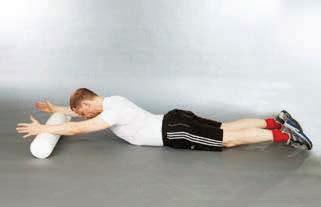
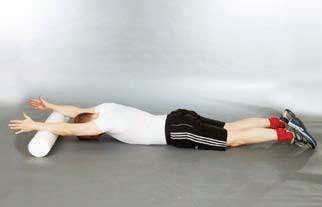
slowly return towards the floor.

Sequencing is the linking of exercises together, to make more complex and challenging routines. These can be set to music in a group situation or, without music, in a one to one personal training session.
Sequencing moves together can help you design and choreograph a core ball class to music, making it a fun and challenging class. It can also be used to progress a client’s personal training workout to offer a new and fresh challenge.

When exercises are chosen that flow smoothly and care is taken to balance muscle groups, a safe and fun all over body workout can be achieved.
When choreographing a group exercise core class, there are a number of considerations that need to be taken into account.
Firstly the space available for the class needs to be reviewed. Sequencing moves together requires additional floor space to safely navigate through the exercises. Ensure participants can fully roll forward on the ball from a kneeling position and not come into contact with anyone else. This may require limiting the number of participants.
If music is to be used, the sequence will be designed around a normal 32-count phrase block of choreography. It is recommended that the music used be around 120 – 128 bpm, to allow safe and fluid transitions from one exercise to the next.
It is important that each move flows smoothly into the next, therefore some moves simply will not mix together. Consideration should be taken when holding positions are incorporated, for example holding a prone position on a Swiss ball can increase blood pressure and cause strain on the spine and wrists.
Rest periods should be considered to release any built up tension.
Before exercises are sequenced together, individual moves should be taught thoroughly and effectively. This is to ensure safe technique is adhered to, so that the participant can gain the full benefit from the sequence.
Once exercises have been individually taught, sequences can be linked in numerous ways. Two examples are listed below.
1. One repetition of each move to make up a sequence that is completed in 32 counts (if teaching to music). This can be completed as an individual block of choreography, or added to other blocks to make a longer and more challenging routine.

2. A number of repetitions of each move linked together, this may take two or three blocks of 32 counts to get through.
When teaching a core class with an exercise to music influence, it is an option to teach the warm up section as a basic aerobics sequence using the ball. This can utilise simple aerobics moves, incorporating the ball to give it a fun, progressive feel. Mobility work and prep stretching can also be combined with the ball and music.
Below is an example of a simple warm up using the ball. The counts are there for guidance and can be adjusted to suit.
Seated warm up
spinal twists
lateral bends
Balance work section
heel lifts
single leg balance (hold each leg for 8 counts)
single leg balance with arm movement (8 counts to change arms)
single leg balance with eyes closed (16 counts per leg) (repeat number of times you want) seated step touch (16 counts)
walk round behind ball (left) (8 counts)
walk round ball (right) (8 counts)
squats behind ball (32 counts)
shift weight, hand on ball (16 counts) step touch rolling ball (16 counts)
double step touch rolling ball (16 counts)
step touch holding ball, plus chest press (16 counts) walk forward and back (8 counts)
walk round ball (left) (8 counts) walk forward and back (8 counts) walk round ball (right) (8 counts)
double step touch/ grapevine, bouncing ball (16 counts) squat behind ball (16 counts)
4 count lunges to left side of ball – right leg (24 counts/ 3 lunges) squat behind ball (8 counts)
4 count lunges to right side of ball – left leg (24 counts/ 3 lunges) squat behind ball (8 counts)
single lunge to left side of ball – right leg (12 counts/ 3 lunges) squat behind ball (4 counts)
single lunge to right side of ball – left leg (12 counts/ 3 lunges) squat behind ball (4 counts)
box ball lunge – lunge left of ball (right leg), squat behind in middle, lunge to right (left leg), squat in middle, 16 counts. (repeat x 4 = 64 counts.)

Prone sequence walk out to plank (8 counts)
press up (8 counts)
jack knife (8 counts)
push back to diver (8 counts)
pull back from diver to plank (8 counts)
press up (8 counts)
jack knife (8 counts)
push back to finish (8 counts) (64 count routine)
hamstring curl roll (8 counts) drop hips down to floor (8 counts)
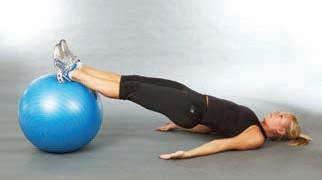
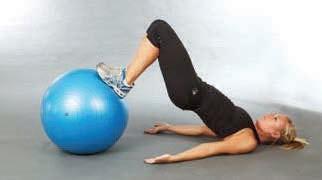
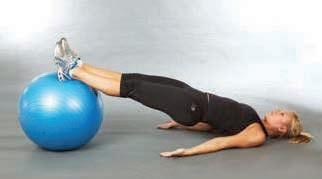
glute squeeze up (8 counts)
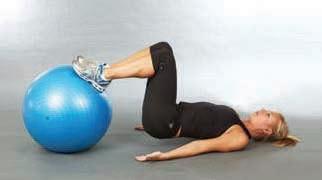
roll legs back out to start (8 counts) (32 count routine)

ball pick up with feet, transfer to hands (4 counts)
lower ball behind head and legs to floor (4 counts)
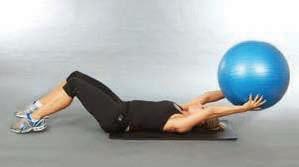
return ball to feet and lower (8 counts)
reverse curl with ball between legs (8 counts)
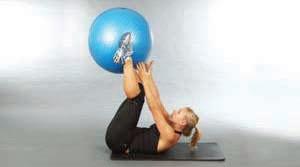
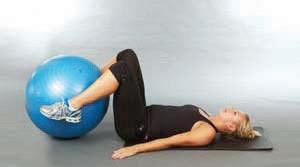
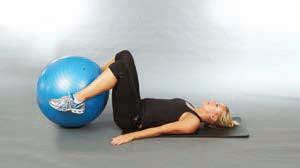
crunch up and tap side of ball (8 counts) (32 count routine)
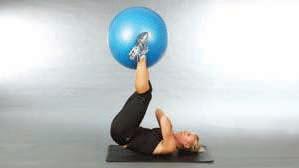
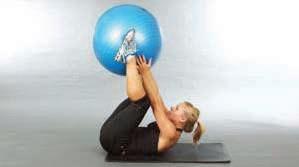


Crunch sequence

crunch x 2 (16 counts) crunch circle x 2 (16 counts)
lift, oblique twist, centre, down x 2 (16 counts)

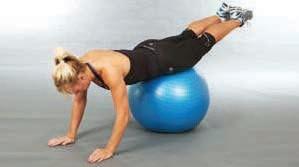
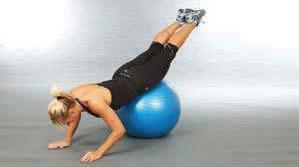
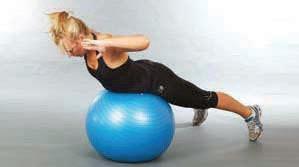
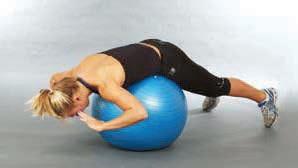
crunch circle x 2 (16 counts) (64 count routine)
Back sequence
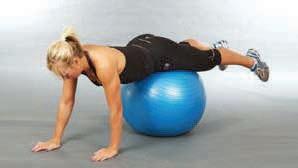
back extension x 2 (16 counts) reverse back extension x 2 (16 counts) walk forward (8 counts) superman right & left (16 counts) walk back to back extension position (8 counts)

Supine leg sequence reverse superman (right & left) (hold 5 secs each)
single leg extension (right) single leg glute squeeze (left)
single leg extension (left) single leg glute squeeze (right)
Repeat 2-3 times
Prone upper body combo single arm extension (right)
press up single arm extension (left) press up
Repeat 8-10 times
YMCAFIT is one of the UK’s leading health, fitness and wellbeing specific training providers. It offers an extensive range of qualifications from Level 2 to Level 4.

To view YMCA FIT’s full range of qualifications please visit www.ymcafit.org.uk.
A: 111 Great Russell Street, London, WC1B 3NQ
W: www.ymcafit.org.uk
© YMCAfit is part of Central Young Men’s Christian Association (Central YMCA). Registered Charity no. 213121. Limited company registered in England no. 119249. Registered address 112 Great Russell St, London, WC1B 3NQ.